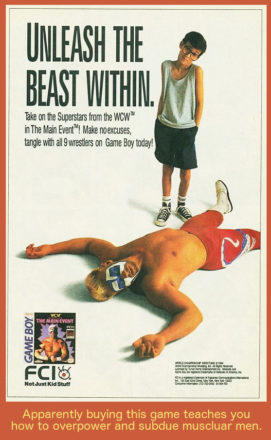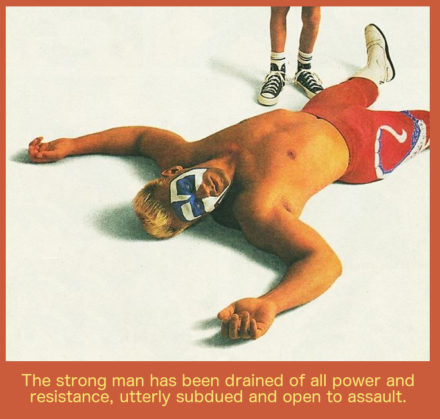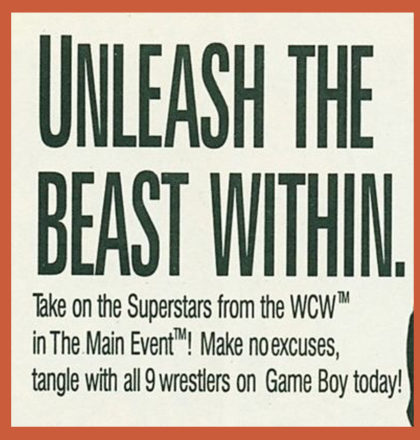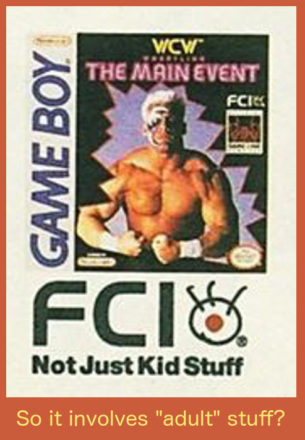 While surfing around Tumblr recently, I saw this interesting print advertisement for a 1990’s era pro wrestling video game. The image captures our attention by presenting a shocking, outrageous scenario: wrestler Sting flat on his back, apparently beaten unconscious by a young Game Boy enthusiast. We are led to understand that the skinny nerd has somehow just finished out-wrestling the veteran pro, his hands casually thrust in his pockets as he shrugs his shoulders over how easily he won their match.
While surfing around Tumblr recently, I saw this interesting print advertisement for a 1990’s era pro wrestling video game. The image captures our attention by presenting a shocking, outrageous scenario: wrestler Sting flat on his back, apparently beaten unconscious by a young Game Boy enthusiast. We are led to understand that the skinny nerd has somehow just finished out-wrestling the veteran pro, his hands casually thrust in his pockets as he shrugs his shoulders over how easily he won their match.
The moral of this story is apparently that, by playing this video game, even a weakling can learn the moves to enabled him to win fights, to defeat bigger, stronger opponents. Our brains make the connection that we too need to get this game so we too can be Winners.
 But as I study this image further, I sense a sub-text to the scenario, a more compelling narrative than a friendly wrestling match with a surprising outcome. I believe this scene is designed to stir up desires in young males beyond just winning fights.
But as I study this image further, I sense a sub-text to the scenario, a more compelling narrative than a friendly wrestling match with a surprising outcome. I believe this scene is designed to stir up desires in young males beyond just winning fights.
The image leaves us pondering what led up to this moment, what happened to render Sting powerless.
I’m sure the advertisers are aware that this scenario — being alone with and in control of an attractive wrestler — is compelling to many potential buyers of this game. So I believe the scene was constructed to spark specific cravings in young males who have watched pro wrestling, gotten excited, and fantasized about getting to do it with one of the wrestlers. The image of the young gamer, alone and fully in control of the desirable adult male, is pure wish-fulfillment for certain young wrestling fans.
I believe Sting’s helpless position, with his open arms, and prominent nipple are meant to arouse potential buyers. His head is tilted toward the camera (toward us, not toward his opponent) so we can see his face covered in that garish, feminizing make-up, with his lips parted invitingly. Sting just happened to fall in a suggestive position that invites the viewer to pounce on him. The proposal made by this advertisement is that acquiring this video game may lead to unrestricted access to shirtless, muscular, appealing, helpless men, and that one can do whatever he wants to them (yes, even THAT!) because they will be submissive.
The image presents a power shift — the adult male with spectacular physique drained of his strength, handing over control of the situation to the weak young gamer. The advertisers encourage the viewer to insert himself in place of the standing winner. Notice that the young gamer in the photo has thick glasses to signal nerdiness, but he is not awkward or ugly in appearance. He is not truly a nerd, so the viewer will be willing to relate to him, to fantasize about being in this role of total mastery over the submissive muscle-man and go forward from there.
 The text adds to the sexual tension with suggestive language. In large bold letters, we are encouraged to “Unleash the Beast,” which could be understood to mean: Whip it out, given that “The Beast” is a common slang term for one’s dick. Some viewers of this ad, seeing Sting shirtless and exposed, may be feeling the need to unleash their beast at this very moment.
The text adds to the sexual tension with suggestive language. In large bold letters, we are encouraged to “Unleash the Beast,” which could be understood to mean: Whip it out, given that “The Beast” is a common slang term for one’s dick. Some viewers of this ad, seeing Sting shirtless and exposed, may be feeling the need to unleash their beast at this very moment.
Or maybe this text is an invitation to undress Sting — to unleash HIS beast from those restrictive red tights since he can’t do anything to stop you at the moment.
Underneath that enticing headline, we are invited to “take on the Superstars” (Take on how, exactly?) and to “tangle with all 9 wrestlers.” The verb “tangle” could be simply another word for “wrestle” or “fight,” but it also has a more charged connotation. The word inspires images of tangled bodies doing other stuff besides just wrestling. What if a guy came up to you on the street and asked: Do you want to tangle? — what exactly would you think he is inviting you to do with him?
This text is basically an invitation to an orgy with 9 wrestlers, which would stir up all sorts of seedy mental images in an adolescent male’s fertile imagination. And this orgy is going to begin “TODAY!” (if we buy this game), so there can be instant gratification. And if we are feeling any anxiety over attending this orgy, we are commanded to “make no excuses.”
 Finally, in the lower corner, perhaps as a subliminal message, we are told this is “Not Just Kid Stuff.” Which means this is Adult stuff. Which means sex stuff, right?
Finally, in the lower corner, perhaps as a subliminal message, we are told this is “Not Just Kid Stuff.” Which means this is Adult stuff. Which means sex stuff, right?
And we see an image of Sting in his flexing glory, penetrating aggressively through a black wall. This display of masculinity and thrusting, flexing power is meant to contrast with the strongman’s above position, being beaten, limp and helpless.
It also provides us with a mental picture of the game’s cover, which will trigger a positive response when we’re at the store and see this game on the shelf. We may not recall WHERE we saw this image or WHY it’s so pleasurable to gaze upon, but we will feel an urge (perhaps even arousal) to want to own the game — our sub-conscious recalling the above photo and the promise that this purchase could lead to full ownership and control of that desirable muscle-man plus eight other Superstars to tangle with.
I believe the creators of this advertisement understood very well the excitement that young men feel over conquest, over the gain or loss of power and authority, over the male physique exposed and available. All of these themes are presented here to entice young men to buy this game. All of these themes are likewise presented in every episode of pro wrestling, to get us to tune it, buy arena tickets, and pay for subscriptions. I’m sold.

Amazing semiotic analysis.
Thanks! 😀